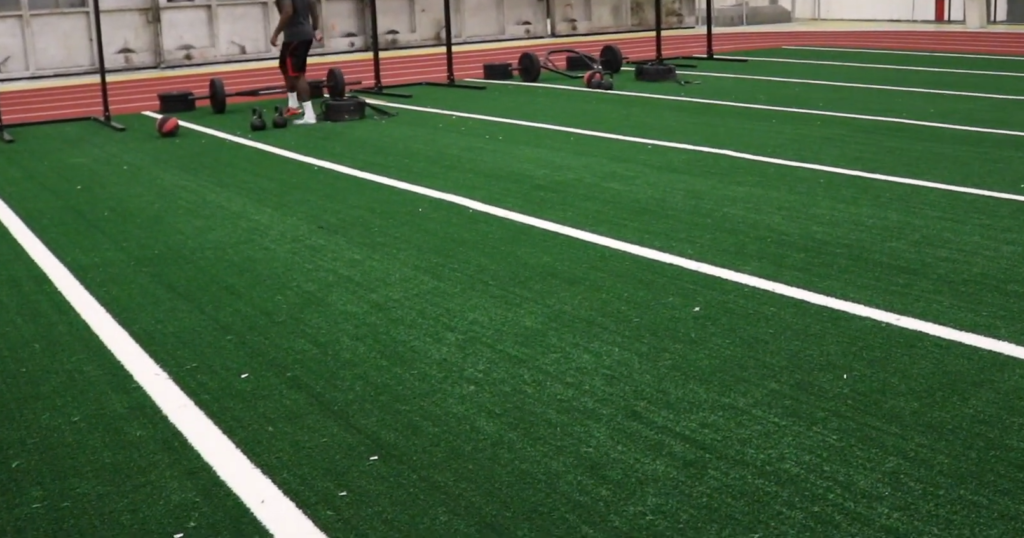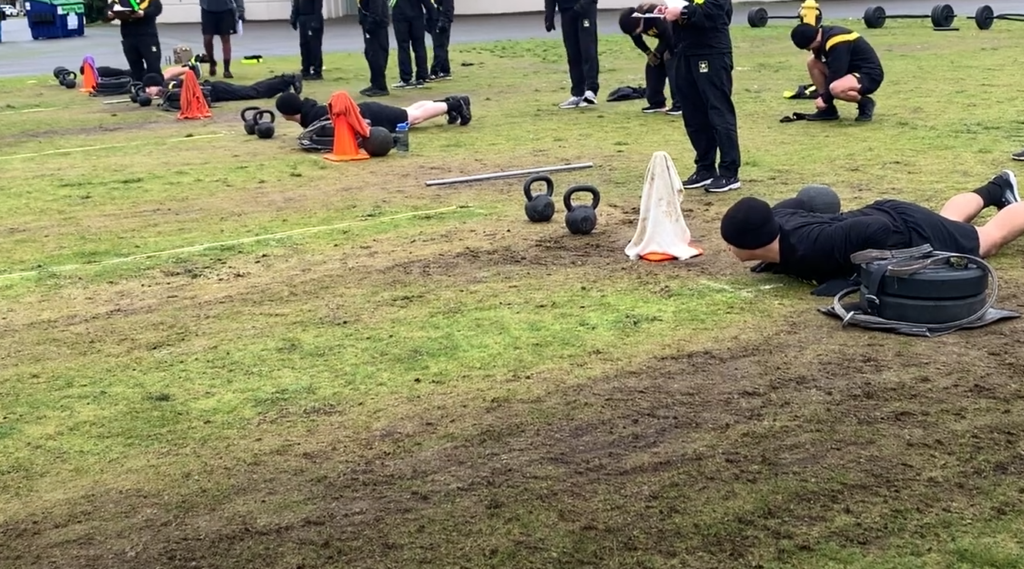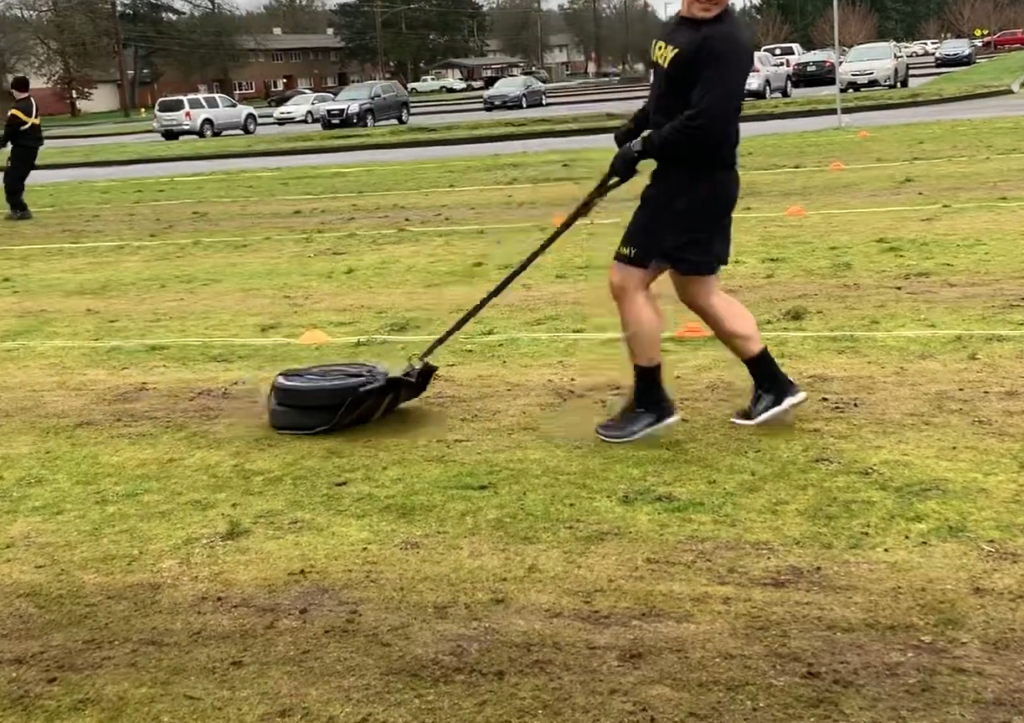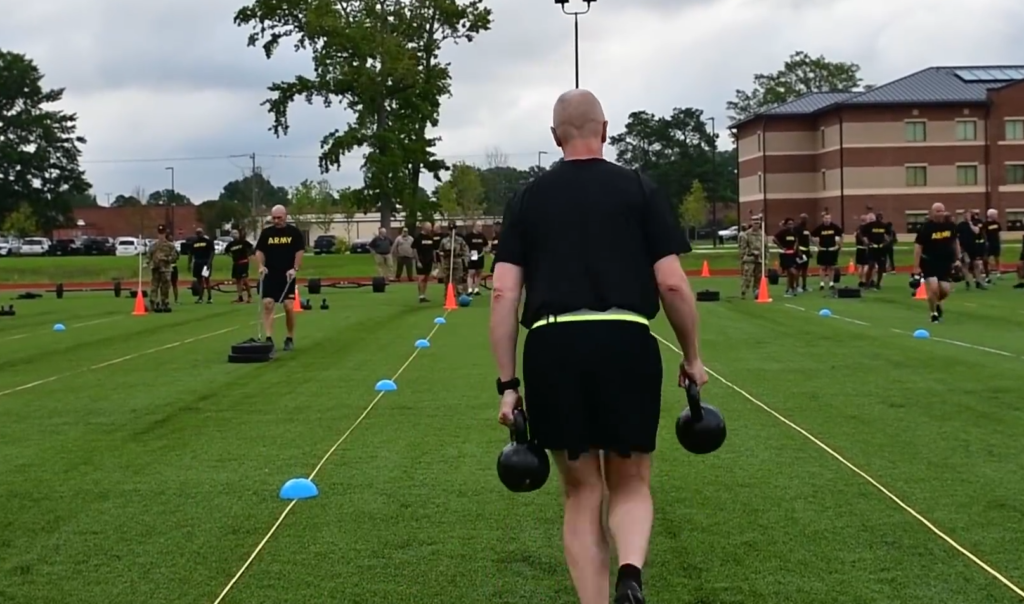The Army Combat Fitness Test (ACFT) represents a formidable shift from the traditional fitness assessments of the past, introducing a holistic measure of a soldier’s combat readiness. At the heart of this rigorous evaluation lies the Sprint-Drag-Carry event, a multifaceted challenge designed to test a soldier’s strength, endurance, and agility under pressure.
This crucial component simulates battlefield movements and tasks, requiring a blend of speed, power, and tenacity. With updated standards that push soldiers to new peaks of physical prowess, understanding and mastering the Sprint-Drag-Carry is essential for meeting the modern demands of military excellence.
Understanding the Army Combat Fitness Test (ACFT)
Before diving into the specifics of the Sprint-Drag-Carry event, it is important to understand the broader context of the ACFT. Introduced with the intent of improving soldier readiness, the test was developed through extensive research by the U.S. Army Center for Initial Military Training.

As of 2023, the ACFT comprises the following events:
- 3-Repetition Maximum Deadlift;
- Standing Power Throw;
- Hand-Release Push-Ups;
- Sprint-Drag-Carry;
- Leg Tuck (or Plank);
- Two-Mile Run;
These events were selected to provide a comprehensive measure of a soldier’s strength, power, speed, agility, cardiovascular endurance, and muscular endurance. They are also meant to reduce preventable injuries and increase soldier deployment readiness [1].
[tds_note]The Sprint-Drag-Carry (SDC) is a pivotal component of the Army Combat Fitness Test (ACFT), which is designed to provide a holistic assessment of a soldier’s physical readiness for combat. The ACFT, a successor to the previous Army Physical Fitness Test (APFT), consists of six challenging events that together measure a wide range of physical capabilities that are essential for effectiveness on the battlefield. The SDC, in particular, simulates movements that are common in combat scenarios and thus serve as a practical evaluation of a soldier’s functional fitness.[/tds_note]
What Is Sprint-Drag-Carry (SDC) As the AFCT Event?
The Sprint-Drag-Carry is the fourth event in the ACFT and is composed of five different and consecutive tasks completed in one continuous effort. The event is designed to mimic critical motions a soldier might encounter in combat such as sprinting under fire, dragging a wounded comrade, carrying ammunition, or moving quickly while staying low to the ground.
Here is a breakdown of the SDC event:
The Sprint
Soldiers begin the event with a sprint. The initial 50-meter dash tests the individual’s ability to rapidly accelerate and reach high speed. This mirrors the need for soldiers to quickly move from one cover to another or charge toward an objective on the battlefield [2].
The Drag
Following the sprint, participants must drag a 90-pound sled backward along the same 50-meter course. This portion of the event assesses lower-body strength and mimics the action of pulling a colleague to safety. It requires not only physical strength but also the ability to effectively use body weight as leverage.
The Lateral
After the drag, soldiers execute the lateral, a side-to-side movement where they shuffle across the 50-meter course and back. This tests agility and the ability to move in different directions quickly, which can be crucial during combat maneuvers.
The Carry
The carry consists of grabbing two 40-pound kettlebells and moving down the 50-meter track and back as quickly as possible. This element simulates carrying heavy equipment or supplies and challenges grip strength, arm endurance, and overall stamina.

The Sprint
To conclude the SDC, the soldier sprints the 50-meter lane once more. This last sprint demands that they summon whatever energy reserves they have left, reflecting the need for sustained speed even when fatigued.
Scoring the Sprint-Drag-Carry Event
In the Sprint-Drag-Carry event, soldiers are timed from the moment they begin the first sprint until they cross the finish line after the final sprint. Speed is essential, and soldiers are encouraged to complete the entire event as quickly as possible.
Each of the six events in the ACFT is scored on a 100-point scale, with a maximum possible score of 600 points for the entire test [3]. The SDC event has specific time standards for achieving scores from 60 (the minimum passing score) to 100. For example, completing the SDC in a shorter time will result in a higher score. This incentivizes soldiers to push their limits and strive for constant improvement.
Training for the Sprint-Drag-Carry Event
Training for the SDC involves a mix of cardiovascular conditioning, strength training, and drills that mimic the movements of each stage of the event. Interval sprinting, strength exercises such as deadlifts and farmer’s walks (which replicate the drag and carry components), and agility drills are all part of an effective SDC training regimen. Moreover, practicing the event itself ensures that soldiers become familiar with the transitions between stages.
The Importance of the Sprint-Drag-Carry
The significance of the Sprint-Drag-Carry within the ACFT lies in its practicality. Every subtask within the event closely resembles real-life actions soldiers are likely to face in the line of duty. It is not just a test of raw physical prowess but also of the ability to perform under pressure and manage transitions effectively. The SDC, therefore, serves as a key indicator of a soldier’s readiness for the physical challenges of combat.
Sprint-Drag-Carry Standards In 2024:
The Sprint-Drag-Carry (SDC) is a component of the Army Combat Fitness Test (ACFT) that assesses a Soldier’s muscular endurance, muscular strength, anaerobic power, and anaerobic endurance. The SDC requires Soldiers to sprint 50 meters, drag a 100-pound sled 50 meters, carry two 40-pound medicine balls 50 meters, and then sprint another 50 meters [4]. The SDC is scored on time, with faster times receiving higher scores.

Purpose
[tds_note]The purpose of the SDC is to assess a Soldier’s ability to perform tasks that require them to move quickly and efficiently over short distances while carrying weight. This ability is important for Soldiers in a variety of combat situations, such as when they need to evacuate casualties, move under fire, or breach obstacles.[/tds_note]
Equipment
The following equipment is required for the SDC:
- A 100-meter track;
- A 100-pound sled;
- Two 40-pound medicine balls;
- A stopwatch;
Pre-Test
Before performing the SDC, Soldiers should warm up with light cardio and dynamic stretches. They should also practice the different movements of the SDC, such as sprinting, dragging, and carrying.
Procedure
The SDC is performed as follows:
- The Soldier stands at the starting line of the track;
- On the command “Go,” the Soldier sprints 50 meters to the sled;
- The Soldier grabs the sled and drags it 50 meters to the medicine balls;
- The Soldier picks up the medicine balls and carries them 50 meters to the finish line;
- The Soldier sprints 50 meters to the finish line;
- The Soldier’s time is recorded from the start of the first sprint to the end of the second sprint;
Scoring
The SDC is scored on a point system, with faster times receiving higher scores. The following table shows the scoring standards for the SDC:
- 17-21 (age) – Male (gender), 2:28 (minimum passing time), 100 (maximum points);
- 17-21 – Female, 3:12, 100;
- 22-26 – Male, 2:23, 100;
- 22-26 – Female, 3:07, 100;
- 27-31 – Male, 2:18, 100;
- 27-31 – Female, 3:02, 100;
- 32-36 – Male, 2:13, 100;
- 32-36 – Female, 2:57, 100;
- 37-41 – Male, 2:08, 100;
- 37-41 – Female, 2:52, 100;
- 42-46 – Male, 2:03, 100;
- 42-46 – Female, 2:47, 100;
- 47-51 – Male, 1:58, 100;
- 47-51 – Female, 2:42, 100;
- 52-56 – Male, 1:53, 100;
- 52-56 – Female, 2:37, 100;
- 57-61 – Male, 1:48, 100;
- 57-61 – Female, 2:32, 100;
- Over 61 – Male, 1:43, 100;
- Over 61 – Female; 2:27, 100 [5];
How Can You Train For The Sprint-Drag-Carry Test?
1. 300m Shuttle:
The 300m Shuttle requires explosive bursts of speed and rapid changes in direction. To enhance your performance, incorporate interval training into your regimen. Focus on high-intensity sprinting with short recovery periods. This could include shuttle sprints, incorporating lateral movements to mimic the test’s demands. Work on your agility and acceleration to navigate the course efficiently.
2. Farmer Carries (Walks):
The Farmer Carries component of the SDC test tests grip strength, core stability, and overall endurance. Training for this can involve weighted carries with kettlebells or dumbbells. Begin with lighter weights and gradually increase the load as you progress. Ensure proper form by keeping your shoulders back and your core engaged. Incorporate variations like uneven carries to challenge your stability further.
3. Sled Dragging:
Sled dragging is an excellent way to build lower body strength and endurance. Load a sled with moderate weight and drag it over various distances. Focus on maintaining a strong posture and driving through your legs. Implement forward and backward drags to simulate the dragging aspect of the SDC test. This exercise not only targets specific muscle groups but also improves cardiovascular fitness.
4. Interval Sprints:
Interval sprints are essential for developing the cardiovascular endurance required for the SDC test. Alternate between short, intense sprints and brief recovery periods. Incorporate different sprinting techniques, such as uphill sprints or incline sprints on a treadmill, to mimic the varied terrain of the test. Gradually increase the duration and intensity of your sprints as your fitness improves.

Consistency is key when training for the Sprint-Drag-Carry test. Design a well-rounded program that addresses each component individually while also incorporating full-body workouts. Additionally, don’t neglect flexibility and mobility exercises to prevent injuries and ensure optimal performance.
Remember to tailor your training to your fitness level and gradually progress to more challenging exercises. By following a structured and focused training plan, you can enhance your abilities and conquer the Sprint-Drag-Carry test with confidence.
Trouble Spots On the SDC
1. Weak Grip Strength:
Challenge: The Farmer Carries and Sled Dragging components heavily rely on grip strength. Weak grip can lead to fatigue and compromised performance.
Solution: Incorporate specific grip-strengthening exercises into your routine, such as forearm curls, plate pinches, and hanging from a bar. Farmer Carries with challenging weights and grip-intensive activities like rock climbing can also improve your grip strength over time [6].
2. Cardiovascular Endurance:
Challenge: The SDC test demands cardiovascular endurance, especially during the interval sprints and shuttle run.
Solution: Prioritize cardiovascular training in your routine. Include high-intensity interval training (HIIT), long-distance running, and aerobic exercises to build stamina. Consistent cardiovascular workouts will enhance your ability to sustain energy throughout the entire SDC test.
3. Agility and Change of Direction:
Challenge: The 300m Shuttle requires quick changes in direction and agility, which can be challenging for those lacking in these areas.
Solution: Focus on agility drills such as ladder drills, cone drills, and shuttle runs. Incorporate lateral movements into your training to improve your ability to navigate tight turns during the shuttle run. Practice specific movements required for the test to enhance your overall agility.
4. Sled Dragging Technique:
Challenge: Improper sled dragging technique can lead to inefficient energy expenditure and increased fatigue.
Solution: Pay attention to your body mechanics during sled dragging. Maintain a strong posture, engage your core, and use your legs to drive the sled. Practice dragging on various surfaces to adapt to different terrains and refine your technique.
5. Overall Strength Imbalance:
Challenge: Weaknesses in specific muscle groups can lead to imbalances, affecting overall performance in the SDC test.
Solution: Incorporate full-body strength training exercises to ensure a balanced development of muscles. Compound movements like squats, deadlifts, and lunges can enhance overall strength. Focus on both upper and lower body strength to perform optimally in all components of the SDC.
Identifying and addressing these trouble spots through targeted training can significantly improve your performance in the Sprint-Drag-Carry test. Tailor your workout routine to target specific weaknesses, and consider seeking guidance from fitness professionals to ensure a well-rounded and effective training plan. Remember, consistency and progressive overload are key factors in overcoming trouble spots and mastering the challenges posed by the SDC test.

Tips for Training SDC:
Training for the Sprint-Drag-Carry (SDC) test requires a combination of strength, endurance, agility, and specific skill development.
Here are some valuable tips to help you effectively prepare for the SDC test:
1. Understand the Test Components:
Familiarize yourself with the details of each SDC component. Knowing the distance, weight, and specific requirements for the shuttle run, farmer carries, sled drags, and interval sprints will guide your training plan.
2. Create a Structured Training Plan:
Develop a well-organized training program that includes a mix of cardiovascular exercises, strength training, agility drills, and sport-specific activities. Plan for gradual progression to avoid overtraining and minimize the risk of injury.
3. Prioritize Cardiovascular Endurance:
Emphasize cardiovascular workouts to build endurance. Include activities like running, cycling, and rowing, and gradually increase intensity and duration. Integrate high-intensity interval training (HIIT) to mimic the demands of the SDC test.
4. Strengthen Grip and Forearm Muscles:
Since grip strength is crucial for components like farmer carries, incorporate grip-specific exercises such as forearm curls, plate pinches, and hanging exercises. Farmer carries with challenging weights will also enhance your grip.
5. Practice Specific Movements:
Devote time to practicing the exact movements involved in the SDC test. Train for agility with ladder drills, cone drills, and shuttle runs. Regularly practice sled dragging and focus on maintaining proper form throughout.
6. Include Full-Body Strength Training:
Strengthen your entire body to ensure a balanced approach. Compound movements like squats, deadlifts, and lunges engage multiple muscle groups, contributing to overall strength and stability.
7. Simulate Test Conditions:
Incorporate training sessions that replicate the conditions of the SDC test. Perform interval sprints on varied terrains, practice farmer carries with weights similar to the test and simulate the sled dragging component to familiarize yourself with the challenges.
8. Work on Change of Direction:
Enhance your agility and ability to change direction quickly. Include lateral movements, cutting drills, and reactive exercises to improve your performance in the shuttle run.
9. Focus on Recovery:
Adequate rest and recovery are crucial. Ensure you have rest days in your training schedule, prioritize sleep, and consider incorporating activities like yoga or stretching to enhance flexibility and reduce the risk of injury.
10. Gradual Progression:
Avoid the temptation to push yourself too hard too soon. Gradually increase the intensity, duration, and difficulty of your workouts to allow your body to adapt and reduce the risk of overtraining.
11. Seek Professional Guidance:
If possible, consult with fitness professionals or coaches who have experience with the SDC test. They can provide personalized guidance, correct your form, and tailor your training plan based on your individual strengths and weaknesses.

FAQ:
1. What is the ACFT regulation for 2023?
The Army Combat Fitness Test (ACFT) regulation for 2023 outlines the requirements and standards that U.S. Army personnel must meet to ensure physical readiness. This includes specific instructions on test administration, scoring, and minimum fitness standards based on age, gender, and military occupational specialty (MOS). The latest regulation should be referenced through official U.S. Army publications or by consulting with a military physical training instructor.
2. What is the Black standard for ACFT?
The Black standard of the ACFT is designed for the most physically demanding MOS categories. Soldiers in these roles are expected to achieve higher scores due to the strenuous nature of their duties. The exact score requirements for the Black standard can be found in the official ACFT materials provided by the U.S. Army.
3. Is 490 a good ACFT score?
A score of 490 is considered excellent on the ACFT, as it exceeds the minimum passing score for all three tiers — Gold, Gray, and Black. The maximum possible score on the ACFT is 600, with 100 points available for each event.
4. How long is sprint-drag-carry?
The sprint-drag-carry is one of the events in the ACFT and consists of five 50-meter shuttles, totaling 250 meters. Participants sprint, drag a sled, carry kettlebells, perform lateral shuffles, and then sprint again.
5. How much weight is the sprint-drag-carry?
During the sprint-drag-carry event, soldiers are required to pull a 90-pound sled for the drag portion and carry two 40-pound kettlebells for the carry portion.
6. Is there an alternate event for the sprint-drag-carry?
As of 2023, there is no direct alternate event for the sprint-drag-carry in the ACFT. However, soldiers with permanent profiles that prevent them from performing certain events may have modifications or alternate assessments as directed by medical personnel and within army regulations.
7. Why did they change the ACFT standards?
The ACFT standards were changed to establish a more accurate assessment of a soldier’s combat readiness with a gender-neutral and age-neutral test that reflects the physical demands placed on soldiers regardless of their roles.
8. What is the ACFT heavy standard?
The ACFT heavy standard applies to MOS classifications that require significant physical demand beyond basic combat tasks. Soldiers in these categories must score at or above a defined threshold to demonstrate their ability to perform heavy physical tasks. The specific score can be found in the latest U.S. Army ACFT guidelines.
9. Is ACFT graded by MOS or unit?
The ACFT is graded based on MOS and its physical demand category—Moderate (Gold), Significant (Gray), or Heavy (Black). Units do not determine the grading; rather, it’s based on the soldier’s assigned MOS.
10. Is the ACFT 4.0 gender-neutral?
Yes, the ACFT 4.0, as of the information available up to 2023, is designed to be gender-neutral, meaning that scoring standards are not differentiated based on gender. All soldiers are expected to meet the same performance metrics.
11. Can you take ACFT in the rain?
The ACFT can be taken in various weather conditions, including rain, as long as the event can be safely conducted without risk of injury to the soldiers participating.
12. Can you wear gloves during ACFT?
Soldiers are permitted to wear gloves during the ACFT, particularly for events like the deadlift, where they might provide additional grip.
13. Can you change shoes during ACFT?
Changing shoes during the ACFT is typically not allowed. Soldiers are expected to wear their physical training uniform and a single pair of appropriate footwear throughout the test.
14. What muscles do sprint-drag-carry work?
The sprint-drag-carry event works several muscle groups, including the quadriceps, hamstrings, glutes, calves, core, upper back, and grip strength.
15. How wide is the ACFT lane?
Each lane for the ACFT is typically 1.5 meters wide to provide sufficient space for soldiers to perform the events without interference.
Useful Video: Demonstration of the new Army Combat Fitness Test
References:
- https://www.dummies.com/article/academics-the-arts/study-skills-test-prep/armed-services/acft-event-sprint-drag-carry-283778/
- https://www.reddit.com/r/nationalguard/comments/129u8ze/180_lbs_for_sprint_drag_carry_in_the_acft/
- https://www.gpshumanperformance.com/tactical-training-the-acft-sprint-drag-carry/
- https://sfnationalguard.com/6-workouts-to-max-the-army-acft/
- https://www.operationmilitarykids.org/sprint-drag-carry-acft-sdc-explained/
- https://www.army-fitness.com/acft-events-parent/sprint-drag-carry/






Leave a Reply